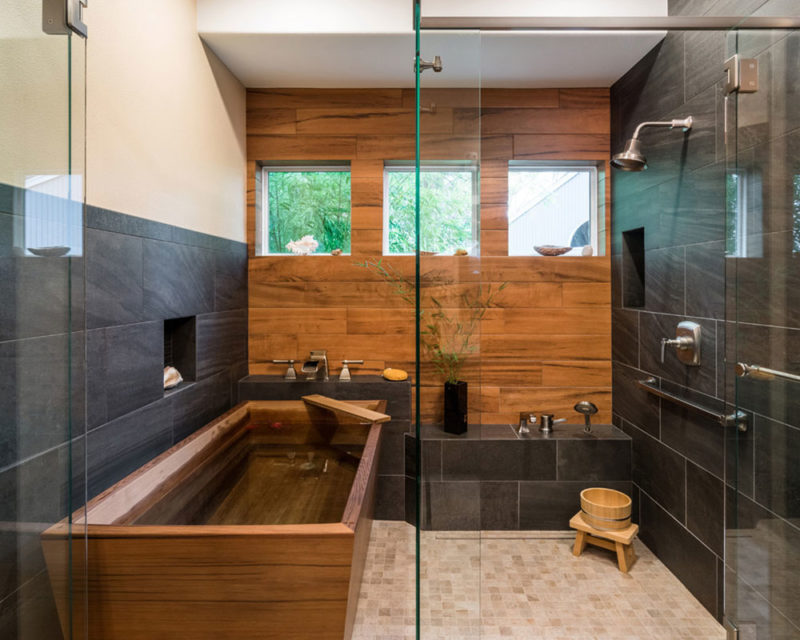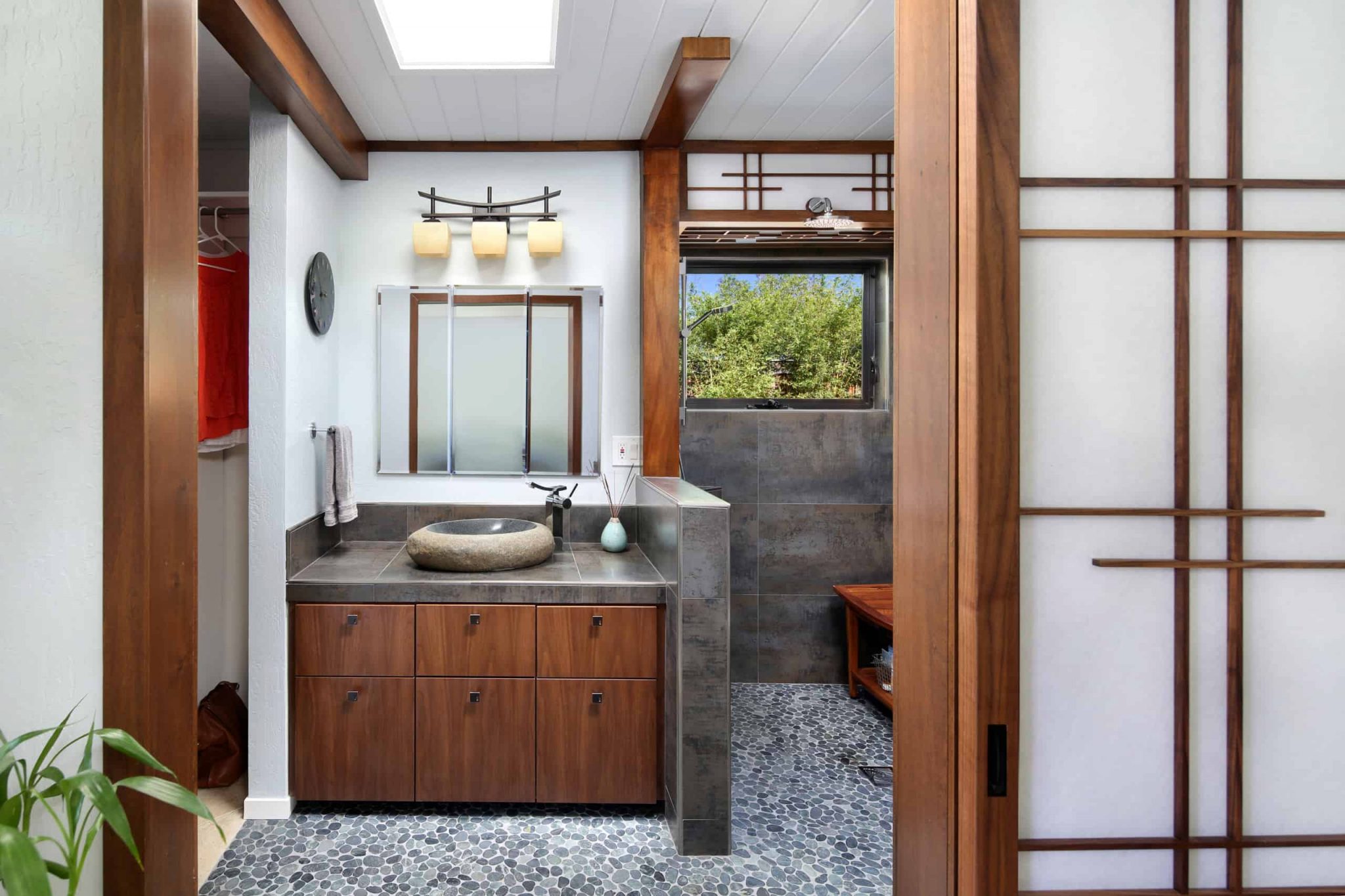The Appeal of Japanese Style Bathrooms in America

The traditional Japanese bathroom, with its minimalist design, focus on functionality, and emphasis on relaxation, is increasingly gaining popularity among American homeowners. This trend reflects a growing appreciation for Japanese aesthetics and a desire for creating tranquil and efficient spaces within the home.
Cultural and Aesthetic Influences
The appeal of Japanese-style bathrooms in America stems from a confluence of cultural and aesthetic influences. American homeowners are drawn to the minimalist design principles that characterize Japanese aesthetics, particularly the concept of “wabi-sabi,” which celebrates the beauty of imperfection and the passage of time. The emphasis on natural materials, such as wood and stone, further enhances the sense of tranquility and connection to nature.
Examples of Japanese Design Elements in American Bathrooms, Japanese style bathrooms in america
American homeowners are incorporating various Japanese design elements into their bathrooms to achieve a distinct aesthetic.
- Tubs: Japanese soaking tubs, known as “ofuro,” are becoming increasingly popular. These deep, rectangular tubs are designed for full-body immersion and are often made from wood or stone.
- Showers: Japanese-style showers often feature a handheld showerhead and a separate shower stall. This allows for a more flexible and efficient showering experience.
- Toilets: Japanese toilets are renowned for their advanced technology and functionality. Features like heated seats, automatic flushing, and bidet functions are becoming increasingly common in American bathrooms.
- Lighting: Soft, diffused lighting is a key element of Japanese bathroom design. This creates a calming and relaxing atmosphere.
- Materials: Natural materials such as wood, stone, and bamboo are commonly used in Japanese-style bathrooms. These materials create a sense of warmth and authenticity.
- Minimalist Decor: Japanese bathrooms typically feature minimal decoration. This allows for a sense of calm and focus.
Key Features of Japanese Style Bathrooms: Japanese Style Bathrooms In America

Japanese style bathrooms, often referred to as “washlets,” offer a unique and sophisticated approach to hygiene and relaxation. These bathrooms are characterized by their minimalist design, emphasis on functionality, and integration of advanced technology.
Layout and Design
The typical layout of a Japanese bathroom often features a separate wet area for showering and bathing, and a dry area for the toilet and sink. The wet area typically includes a soaking tub, a showerhead, and a bench or stool for sitting. The dry area is often characterized by its minimalist design, with sleek fixtures and a focus on cleanliness.
Materials
Japanese bathrooms often utilize natural materials like stone, wood, and tatami mats to create a serene and inviting atmosphere. Stone is frequently used for the floors and walls, adding a sense of durability and elegance. Wood is often incorporated into the design of the tub, shower, and vanity, adding warmth and a touch of nature. Tatami mats, made from woven rush, are sometimes used as flooring in the dry area, providing a soft and comfortable surface.
Soaking Tubs
A central feature of Japanese style bathrooms is the soaking tub, often referred to as an “ofuro.” These tubs are typically deep and spacious, designed for full-body immersion. Soaking in an ofuro is considered a relaxing and therapeutic experience, promoting both physical and mental well-being. The tubs are often made from materials like wood, ceramic, or acrylic, and may include features like jets or built-in heating systems.
Washlet Toilets
Another prominent feature of Japanese bathrooms is the “washlet,” a toilet with integrated bidet functionality. Washlets offer a variety of features, including heated seats, adjustable water pressure and temperature, and even air drying capabilities. These advanced toilets are designed to enhance hygiene and comfort, offering a more comprehensive and convenient cleaning experience.
Heated Floors
Many Japanese style bathrooms feature heated floors, often known as “ondol.” These floors provide warmth and comfort, especially during colder months. Heated floors can also help to prevent mold and mildew growth, contributing to a healthier and more hygienic bathroom environment.
Benefits and Challenges of Japanese Style Bathrooms in American Homes

The allure of Japanese-style bathrooms extends beyond aesthetics, offering a unique blend of comfort, relaxation, and functionality that many American homeowners find appealing. However, integrating these designs into American homes presents certain challenges that require careful consideration. This section explores the advantages and drawbacks of incorporating Japanese bathroom features into American lifestyles.
Advantages of Japanese Style Bathrooms
The appeal of Japanese bathrooms lies in their emphasis on creating a serene and functional space for personal hygiene and relaxation. Here are some of the key advantages they offer:
- Enhanced Comfort and Relaxation: Japanese bathrooms often feature heated floors, known as “oshiire,” which provide warmth and comfort during the colder months. Additionally, the use of natural materials like wood and stone creates a calming and spa-like ambiance, promoting relaxation and stress reduction.
- Improved Hygiene: Japanese bathrooms prioritize cleanliness and hygiene through features like bidets, which offer a more thorough and hygienic cleansing experience compared to traditional toilet paper. The use of separate showers and bathtubs also helps maintain cleanliness and prevent the spread of germs.
- Space Efficiency: Japanese bathrooms are known for their efficient use of space, often incorporating multi-functional fixtures like showerheads that double as hand showers. This design approach is particularly beneficial for smaller American homes where space is limited.
Challenges of Adapting Japanese Style Bathrooms to American Homes
While the benefits of Japanese bathroom design are undeniable, adapting these features to American homes presents some challenges.
- Cultural Differences: The concept of bathing and showering in Japan differs from American practices. In Japan, bathing is often a ritualistic experience that involves soaking in a bathtub for extended periods, while Americans tend to prefer quicker showers. This cultural difference can affect the design and use of bathtubs and showers in American homes.
- Cost Considerations: Implementing Japanese bathroom features, such as heated floors, bidets, and high-tech toilets, can be significantly more expensive than traditional American bathroom fixtures. This cost factor may be a deterrent for some homeowners, especially those on a tight budget.
- Space Constraints: While Japanese bathrooms are known for their space efficiency, adapting these designs to American homes, particularly older homes with smaller bathrooms, can be challenging. The installation of features like bidets or heated floors may require significant modifications to existing plumbing and electrical systems.
Comparison of Practicality and Aesthetics
The practicality and aesthetics of Japanese-style bathrooms differ significantly from traditional American bathrooms.
- Practicality: Japanese bathrooms emphasize functionality and efficiency, prioritizing features like bidets and heated floors that enhance hygiene and comfort. American bathrooms, on the other hand, tend to prioritize space and accessibility, often featuring larger showers and bathtubs.
- Aesthetics: Japanese bathrooms often incorporate natural materials like wood and stone, creating a serene and minimalist aesthetic. American bathrooms, in contrast, may feature a wider range of styles, from modern and sleek to traditional and ornate.